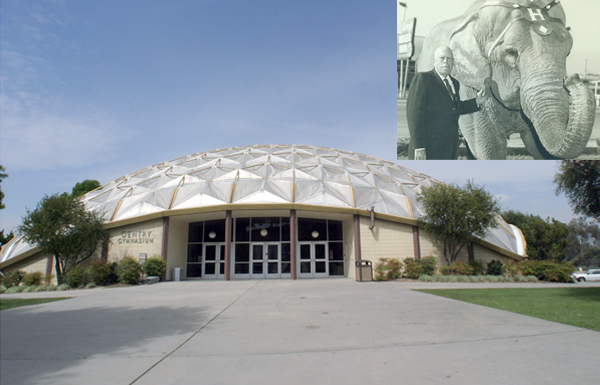Last week’s trivia challenge posed this question: What unique campus structure at Loma Linda University Health had its groundbreaking in 1966?
The building is no longer on campus, but its shiny roof can now be seen among the orange groves of Loma Linda at the future site of the Loma Linda Family Community Center, which is an outreach of the Loma Linda Spanish Church.
“It is good to see the old rooftop shining again,” said trivia entrant Lisa Stuck. Another entrant, Nick Frantz, described it as “kind of like a giant golf ball,” while Anuradha Diekmann called it “Loma Linda’s Epcot Center.” In geometric terms, it had a geodesic rooftop, as noted by entrants Delia Sanchez, Robert Meyrahn, Carolyn Marovitch, and Larry Beeson.
The building was the Dale Gentry Gymnasium, which was torn down in 2005–06 to make way for the Centennial Complex. The three random winners correctly naming the building are Valerie Downs, Jim Lewis, and Jennifer Rodriguez. Winners, please email pr@llu.edu to claim your prize, which must be picked up within 60 days.
Opened in 1968, the gymnasium was named after entrepreneur and businessman Dale Gentry, who donated the California Hotel in San Bernardino to Loma Linda University, the sale of which helped make the new gymnasium possible. “He was a poor farm boy who made it rich,” writes Richard Schaefer, historian for Loma Linda University Health.
Built in 1926, the storied California Hotel hosted celebrities and sports teams through the years, among many other guests, according to Schaefer. General George Patton took over the California Hotel as an Army headquarters immediately after the Dec. 7, 1941, bombing of Pearl Harbor.
World War II also deeply affected the College of Medical Evangelists (CME), as Loma Linda University was then called. Among the ways was that the military assumed the right to select students for medical schools. This posed a concern for CME, which wanted to continue training students who aligned with its Christian, mission-oriented approach to healing. What happened next is described in this passage from “The Impossible Dream: Railway to the Moon” by Ken McFarland, which tells the story of Loma Linda University Health’s first 100 years.
This week’s trivia challenge is to fill in the name and title of the man sent to Washington, DC, to solve this problem for CME.
“Faced with this complication, the CME Board of Trustees sent ____________________ to Washington, D.C. And evidence seems convincing that divine providence had already anticipated this emergency and had been preparing the way to meet it. In Washington, ____________________’s first stop was to visit with one of his own CME classmates – Walter S. Jensen, MD (class of 1924), who now served as a colonel in the U.S. Air Corps. Dr. Jensen could readily understand CME’s plight, but he did not have the authority to mold military policies relating to medical schools. Nonetheless, he could open doors for ____________________, and arranged for [him] to see Colonel F.M. Fitz in the Surgeon General’s office. Colonel Fitz was very receptive to ____________________’s appeal and said, “I will refer you to Colonel White, who is in charge of drafting plans for assignments to medical schools." At last, ____________________had reached the man who did have the authority to get things done on CME’s behalf.
What happened next, some might see as simple coincidence. Those familiar with the repeated evidence of divine involvement through the years in time of crisis at Loma Linda would see it as yet another such providential intervention.
As ____________________ presented CME’s dilemma to Colonel White, a solider entered his office, saluted, and delivered a sealed envelope to the colonel. Colonel White returned the soldier’s salute, accepted the envelope, and dismissed the courier. Momentarily, he interrupted his conversation with ____________________ to open the envelope, and discovered to his surprise and delight that he had just been promoted to the rank of brigadier general.
____________________ remained convinced after that meeting that the now General White’s elation at that moment spilled over into the matter under discussion and prompted from him a spontaneous promise: “I will keep you folks in mind.” And that, he did. CME would become the only school of medicine in America allowed to choose its own students, starting with Seventh-day Adventists about to be assigned to other schools.
Please email the missing name and his title at CME to pr@llu.edu by midnight Tuesday, Jan. 13, for the chance to be a random winner. One answer per person. Good luck!

